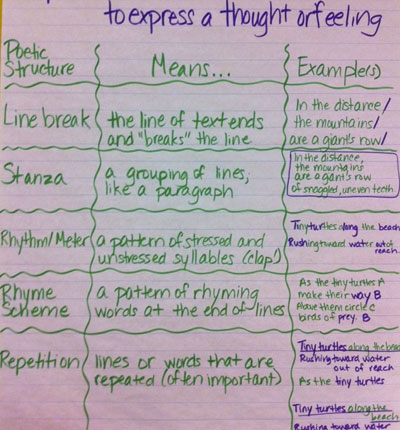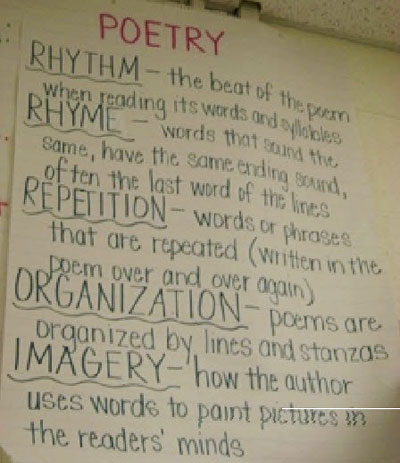I just LOVE teaching poetry! I try diligently to incorporate it throughout the year at various times for general exposure, and specifically to help my kiddos see that our reading strategies can be used across a wide variety of texts. The writers of the Common Core started including poetry in the majority of the reading standards, so students would have many opportunities to read, decipher and distinguish poetry that they enjoy … or don’t! Poetry can be a very useful tool when helping students understand and compare text. After state testing, I find that students enjoy some in-depth work within the poetry genre — especially rating poems and understanding their thoughts about various poetry.
Expose!
We spend an ample amount of time discovering various poems! I enjoy giving students copies of the poems so they can highlight and write notes in the margins of the aspects they enjoy about each poem — rhyming words, alliteration, imagery, vocabulary, etc. I choose the poems at first, giving them a variety of poetry that utilizes different techniques. After students highlight or write notes, they must rate each poem (1, 3, or 5). Each student receives a poetry folder and a rating sheet , where they list poems they read, the name of the poet and their rating. One strategy I discovered was having students create a chart of two 1’s, two 3’s and two 5’s. This helps students to see correlations between poems that they rate at each point level. We make it perfectly okay to NOT like a poem, but you must explain why!
Respond
I find that most kids can tell you what they do and don’t like about a poem, but they don’t have the vocabulary to name the specific technique. After a day or two immersing ourselves in various poems, we create an anchor chart with different techniques poets use, such as alliteration, repetition, onomatopoeia, rhyme, figurative language, imagery, robust vocabulary, etc. After we create this anchor chart, it is an expectation that when students respond to poetry that they use these terms when they critique poems. I also explicitly teach each term, so students have an abundant amount of examples to compare. I found this blog where the teacher used a poem to create a sense of wonder and collaboration, while critiquing the poem with deeper level thinking. This is what we look for when it comes to responding to poetry. Statements that begin with ‘I wonder,’ ‘I enjoy,’ ‘I noticed,’ and ‘It creates in me’ are all great ways to get students responding to poetry!
Poetry Anchor Chart: Structure

Poetry Anchor Chart: Vocabulary

Round Robin
I use Round Robin in my classroom quite a bit. It’s a simple strategy that involves students moving around the classroom, working together to solve different questions/problems, read different texts, and discuss questions. In our poetry unit, I have different poems around the classroom and students move in their groups to each poem and rate it. They have a short discussion using the poetry vocabulary and techniques we have learned, rate the poem and then respond individually when they are back at their seats.
Bringing It Together
After immersing ourselves in poetry for a week or two, we continue to bring in longer, deeper thinking poems that challenge students to think outside the box, and break down poetry to discover its meaning or message. With many of our new Common Core standards, I try and bring in constructed writing opportunities with poetry as well! I also enjoy bringing in a poetry writing station, as this also opens up the creative, right-sided brain of my kiddos! Here’s a list of 25 different types of poetry kids can take a stab at!
Poetry is a GREAT experience for students and their teacher — especially after so much of fiction and nonfiction throughout the year! Take time to immerse your class in a poetry unit that challenges their opinions and pushes their thinking to new discoveries!
